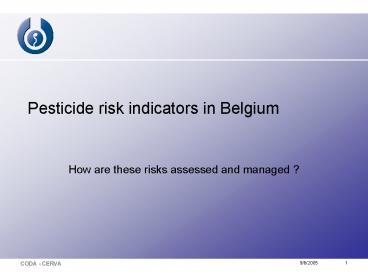Pesticide risk indicators in Belgium - PowerPoint PPT Presentation
1 / 24
Title:
Pesticide risk indicators in Belgium
Description:
CODA - CERVA. 9/6/2005 1. Pesticide risk indicators in Belgium ... CODA - CERVA. 9/6/2005 9. The Risk assessment is function of both toxicity and exposure ... – PowerPoint PPT presentation
Number of Views:36
Avg rating:3.0/5.0
Title: Pesticide risk indicators in Belgium
1
Pesticide risk indicators in Belgium
- How are these risks assessed and managed ?
2
Hazard and Risk
- Hazard (danger gevaar)
- potential to cause a damage
- characteristic to a agent
- impossible to control.
- Risk (risque risico)
- probability for a damage to occur
- dependent of the circumpstances (does,
protection, susceptibility, ) - possible to control (prevention).
Cours de toxicologie industrielle MDTR 2111
(UCL)
3
Pesticide use and risk
Risk assessment Poison is in everything, and
no thing is without poison. The dose makes it
either a poison or a remedy Paracelsus,
XVIth century
- Risk management
- we can deal with hazard if the risk is low
(acceptable) enough Cours de toxicologie
industrielle (UCL MDTR 2111)
4
Risk valuation a question of treshold value
threshold ?
threshold ?
Cours de toxicologie industrielle (UCL MDTR
2111)
5
Pesticides are generally used in an open
environment
6
and have effects on numerous non-targeted
compartments
7
Pesticides are wildely used
In Belgium, about 9 300 tons of pesticides
(active substance) were used in 2000 by
farmers professionals of nature
management communities railways gardeners.
NSPIU Not Sufficiently Precise Identified Use
8
Pesticide distribution among crops in Wallonia
(year 2000)
9
The Risk assessment is function of both toxicity
and exposure
Pesticide Risk Indicator
10
The Exp/Tox ratio is compared to a norm
Exp
Measured exposure
Acceptable ratio
Damages exposure
Norm
Tox
11
e.g. Which is the risk for fishes ?
Exp
a.s.surface water
0.01
LC50 fish
Norm
Tox
Uniform Principles CEE 91/414
a.s. active substance
12
Risks are specific to particular compartments
- Pesticide Risk Indicators are to be specific for
- Human concern (consumer, farm worker, etc.)
- Flora fauna concern (fishes, birds, mammals,
earthworms, bees, etc.)
13
Multi-compartimental indicators are adapted to
address more general question
POCER - 1 Pesticide OCcupational and
Environmental Risk indicator
(Vercruysse Steurbaut, 2002)
14
Local ? General risk assessment
Presently, indicators are mainly devoted to
assess the risk at a local level
- For one component (fish, birds, )
- In one place
- At one moment
- With one active substance
- For a specific hazard
No risk aggregation
But, in general, question about pesticide risk
are very much global
- For many components
- In several places or a region
- At several moments, generally a year
- With several actives substances
- For several hazards
High risk aggregation level
15
Risk aggregation is generally simplified by a
simple sum
- Index of loads (IL) for Belgium on bees, birds
and earthworms
16
Such rough risk aggregation sheme provide very
global information
As, for example
- A general reduction of pesticide use would mainly
benefit to earthworms - A reduction of insecticides would be more
effective to reduce the risk on the three
assessed compartments (50 of the bees risk is
due to a single a.s.
17
For more detailled information at a high
aggregation level this is another story
- There is a need of a detailled information for
exposure - Where are the pesticides applied?
- Which formulation (liquid, powder, granules, )?
- At which dose ?
- When ?
- The risk is then calculated for each specific
exposure - There is a need to aggregate the risk
- For components
- For active substances
- For locations
- For periods
- For hazards
18
Information is now available for each Community
- Pesticide application (kg a.s. in 2000 at Ittre,
sandy-loam region)
19
While pesticide quantities are easily summed ,
Pesticide distribution among regions in Wallonia
(tons) (year 2000)
20
for pesticide risks, we must deel with a surface
aggregation,
Example of risk scores (ri) for a single
compartment (e.g. bees) from a same a.s.
application on three regions
r1
Riskglobal ?
r2
r3
e.g.
with wi weighting factor f(area pest. use )
21
a time aggregation,
Example of a risk assessment on a single
compartment from four same a.s. applications on a
same field.
year risk
r1
r2
r3
r4
t1
t2
t3
t4
ty
- Year risk (risk ty) ?
- e.g. ? ri ? riki where ki f(DT50 ty-ti)
- ! riskshort-term gt risklong-term
22
the active substance aggregation,
Example of a risk assessment of a single
compartment from an application of a pesticide
with three active substances
- Global risk ? ri average (ri) max (ri) .
? - Is there synergy, antagonism, ?
23
, and a compartment aggregation
Example of the risk assessment of a single a.s.
application on three compartments
- Risk global ?
- rbirds rbees rhuman
- max (r1, r2, r3)
- rc1wc1rc2wc2rc3wc3 where wc weighting
factors for compartment importance f(various
opinions)
24
And also,
- For Belgium, the risk approach is developped in
the PRIBEL (Pesticide Risk Indicator for BELgium)
with UGent. - At the European level, the same risk approach is
studied in the HAIR (HArmonised environmental
Indicators for pesticide Risk) research with 18
research teams. - There is also a place for societal interaction
into the pesticide risk assessment methods, this
aspect is studied in a BELSPO project named PEPAM
(PEsticide risk PArticipatory Model) in
collaboration with UA and ULG. - Pesticides risks are managed by several
agricultural methods in a BELSPO project named
LABEL realised in collaboration with UGent and
ULG.































